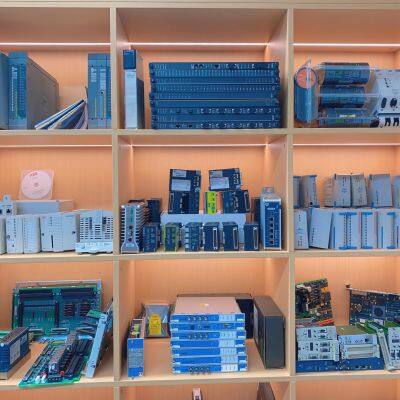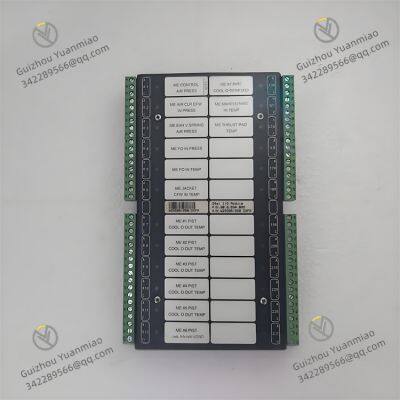Product Description
I. Overview
Praxis 98.6.034.800 is an intelligent hybrid I/O module that integrates digital, analog input/output and high-speed counting functions. It is designed to meet the high requirements for signal processing speed, control precision and network compatibility in scenarios such as precision manufacturing, energy management, and intelligent warehousing. As a key node in industrial control systems, it can realize efficient data interaction between on-site equipment and upper computers, providing comprehensive support for the intelligent regulation of production processes, and performing particularly prominently in complex systems that require real-time monitoring and rapid response.
Taking the new energy battery production line as an example, this module can connect devices such as laser thickness gauges (analog input) and robotic arm limit switches (digital input) to collect parameters such as battery pole piece thickness and robotic arm position in real time; at the same time, it controls the coating speed of the coater through analog output, controls the start and stop of the conveyor belt through digital output, and records the production quantity with the high-speed counting function, ensuring the precise synchronization and efficient operation of the entire production process.
II. Technical Parameters
Power supply parameters: Adopts 24V DC power supply, with an operating current ≤ 500mA and a power ripple rejection ratio ≥ 60dB. It can work stably in industrial environments with a voltage fluctuation of ±15%, ensuring the continuous and reliable operation of the module.
Digital input: 12 digital input channels, supporting dry contacts and NPN/PNP type signals, with an input voltage of 10-30V DC, a response time ≤ 0.2ms, and supporting high-speed pulse capture (up to 10kHz), suitable for signal acquisition of rapid state changes.
Digital output: 10 digital output channels, each with a maximum output current of 3A and an output voltage of 24V DC, supporting short-circuit protection (automatic recovery), and can directly drive loads such as contactors and high-power solenoid valves.
Analog input: 6 analog input channels, supporting 4-20mA DC, 0-10V DC, -10V-+10V DC signals, with a resolution of 24 bits, a sampling rate of 100Hz, a measurement accuracy of ±0.05% FS, and equipped with hardware filtering function, having strong anti-interference ability.
Analog output: 6 analog output channels, supporting 4-20mA DC and 0-10V DC signals, with a resolution of 18 bits, an output accuracy of ±0.1% FS, and an output response time ≤ 1ms, enabling high-precision continuous adjustment.
High-speed counting: 2 high-speed counting channels, supporting incremental encoder signals (A/B phases), with a maximum counting frequency of 100kHz, which can be used for precise measurement of parameters such as rotational speed and displacement.
Isolation performance: Enhanced optoelectronic isolation is adopted between input, output and power supply, with an isolation voltage ≥ 4000V AC (for 1 minute), and an isolation voltage between channels ≥ 1000V AC, effectively blocking common-mode interference and differential-mode interference.
Environmental adaptability: Operating temperature ranges from -40°C to +85°C, relative humidity is 5%-95% (no condensation), vibration resistance is 10-2000Hz with an acceleration of 20g, and impact resistance is 100g (11ms half-sine wave), adapting to extreme industrial environments.
Communication interface: 1 Gigabit Ethernet interface (supporting MODBUS TCP/IP and PROFINET protocols), 1 RS-485 interface (supporting MODBUS RTU and Profibus-DP protocols), supporting dual-network port redundancy design, with a maximum data transmission rate of 1000Mbps.
Dimensions: DIN rail mounting, size 160mm×100mm×70mm (length × width × height), protection class IP20, suitable for dense installation in control cabinets.

III. Functional Features
Multi-dimensional signal integration processing: Integrating digital, analog and high-speed counting functions, it can process switching signals, continuous quantity signals and high-speed pulse signals at the same time without additional configuration of dedicated modules, greatly simplifying the system architecture and reducing hardware costs.
Ultra-high precision and high-speed response: 24-bit analog input resolution and 18-bit analog output resolution, combined with 0.05% measurement accuracy, meet the strict requirements of precision manufacturing for parameter control; 0.2ms digital response time and 100kHz high-speed counting capability ensure accurate capture and real-time processing of rapidly changing signals.
Enhanced anti-interference and reliability design: Through multiple measures such as high-voltage isolation, hardware filtering and short-circuit protection, it can maintain signal stability in strong electromagnetic interference environments (such as welding workshops and motor clusters); wide temperature design and anti-vibration and impact performance ensure long-term reliable operation of the module under extreme working conditions.
Flexible and compatible industrial communication: Supports a variety of mainstream industrial bus protocols and Ethernet protocols, and can seamlessly connect to PLCs and SCADA systems of brands such as Siemens and Rockwell. The dual-network port redundancy design improves the reliability of the communication link, meeting the uninterrupted communication needs of key systems.
Intelligent diagnosis and remote management: Built-in perfect self-diagnosis function, which can monitor power abnormalities, channel faults, communication interruptions and other states, and upload fault information through indicator lights and communication protocols; supports remote firmware upgrade and parameter configuration, reducing on-site maintenance workload and improving system operation and maintenance efficiency.
IV. Common Faults and Solutions
Inaccurate high-speed counting
Possible causes: Poor shielding of encoder signal cables introduces noise; counting frequency exceeds the channel upper limit (100kHz); incorrect wiring between encoder and module; wrong counting mode setting.
Solutions: Replace with twisted-pair shielded signal cables, ensuring the shield layer is grounded at one end; reduce the signal frequency to the rated range or replace with a higher-specification module; check the A/B phase wiring of the encoder to ensure it corresponds to the module pins; reconfigure the counting mode (such as increment/decrement, quadrature decoding) and restore default parameters.
Large fluctuation of analog output
Possible causes: Mismatched load impedance of the output channel (500Ω-1kΩ is recommended); unstable power supply voltage of the module; excessive length of output cables introduces interference; failure of the D/A conversion circuit.
Solutions: Adjust the load impedance through matching resistors; check the power supply to ensure the voltage is stable at 24V DC±10%; shorten the length of output cables or use shielded cables, keeping away from high-voltage lines; if the circuit is faulty, replace damaged components or the module.
Frequent protection of digital output channels
Possible causes: Load current exceeds the 3A rated value; the load has inductive surges (such as motors, solenoid valves); oxidation of terminal blocks leads to excessive contact resistance; misoperation of the protection circuit.
Solutions: Add intermediate relays to expand load capacity or replace with low-power loads; connect freewheeling diodes in parallel at the load end to suppress surges; clean the terminal blocks and re-tighten them; if misoperation is frequent, upgrade the module firmware or replace the channel.
Failure to switch communication protocols
Possible causes: The module is not restarted when switching protocols; the firmware version does not support the target protocol; conflicts in communication parameters (such as baud rate, device address); damage to the interface hardware.
Solutions: Restart the module after switching protocols and wait for parameters to take effect; upgrade the module to the latest firmware that supports the target protocol; reconfigure communication parameters to ensure consistency with the system; detect the pin voltage of the interface, and replace the communication interface module if the hardware is damaged.


Emerson VE4013S2B1 Standard I/O Termination Block
Emerson VE4017P0 M-series H1 I/O Interface Card
Emerson VE4022 M-series Profibus DP Series 2 Plus Interface Card
Emerson VE4032S1T2B1 DeltaV M-series Traditional I/O
Emerson VE4033S2B1 Redundant Analog Input Card
Eaton XVH-340-57CAN-1-10 Touch Panel
Eaton XVH-340-57MPI-1-13 Touch Panel
WOODHEAD APP-ETH-PCU PCU2000ETH Ethernet Network Interface PCI Card
WATLOW ANAFAZE CLS208 Temperature Controller
WATLOW ANAFAZE CAS 16CLS/CAS Temperature Controller
Yokogawa UP55A-001-11-00 Profile Controller
TOSHIBA USIO21 Distributed Control System
 yezi
Hi there! Welcome to my shop. Let me know if you have any questions.
yezi
Hi there! Welcome to my shop. Let me know if you have any questions.


